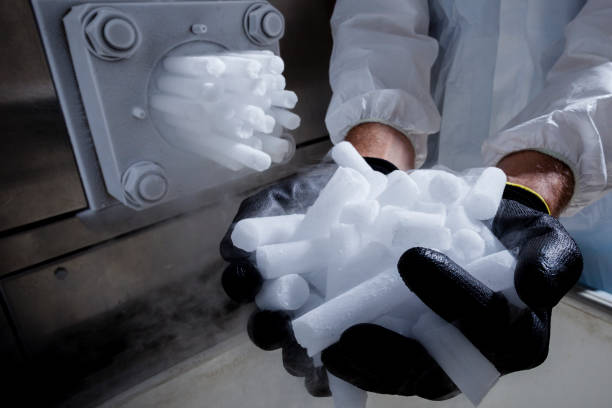The 10 Dynamic Applications of Dry Ice: Unleashing its Versatility in Cleaning, Pest Control, and More!

Dry ice, also known as cardice, is the solid form of carbon dioxide. It is commonly used in the food industry for preserving food and in the medical industry for transporting certain goods, but it has many other versatile uses that you may not be aware of. In this article, we’ll discuss the versatile uses of dry ice that you need to know.
Table of Contents
What is Dry Ice?
How is Dry Ice Made?
The Physical Properties of Dry Ice
The Versatile Uses of Dry Ice
Food Preservation
Shipping and Transporting Goods
Fog and Smoke Effects
Dry Ice Blasting
Refrigeration and Cooling
Carbonation of Beverages
Insect Control
Laboratory Use
Cleaning and Maintenance
Artistic and Decorative Uses
The Safety Precautions You Should Take When Handling Dry Ice
Conclusion
FAQs
What is Dry Ice?
Dry ice is the solid form of carbon dioxide, which is a gas that we exhale and that is present in the atmosphere. Carbon dioxide is also produced by many industrial processes and is commonly used in the production of beverages.Dry ice, also known as cardice, is the solid form of carbon dioxide. It is commonly used in the food industry for preserving food and in the medical industry for transporting certain goods, but it has many other versatile uses that you may not be aware of. In this article, we’ll discuss the versatile uses of dry ice that you need to know.This article explores the various uses of dry ice beyond the food and medical industries. From cleaning and maintenance to insect control and artistic purposes, dry ice has many versatile applications. However, it is important to take safety precautions when handling this substance, as it can be dangerous if not handled properly. This article provides an overview of the uses of dry ice and safety measures to follow.
How is Dry Ice Made?
Dry ice, also known as solid carbon dioxide (CO2), is a fascinating substance that has a multitude of uses, from preserving perishable goods to creating spooky fog effects at Halloween parties. But have you ever wondered how this mysterious substance is made? In this article, we’ll take you on a journey through the fascinating process of dry ice production, uncovering the science and practical applications along the way.Before delving into the production process, it’s essential to grasp the basics of dry ice. Dry ice is unique because it doesn’t melt into a liquid like regular ice; instead, it sublimates directly from a solid into a gas. This intriguing property makes it a valuable tool in various industries, including shipping, medical, and entertainment.
Dry ice is made by compressing and cooling carbon dioxide gas to its liquid form. The liquid carbon dioxide is then allowed to expand, which causes it to freeze and turn into dry ice.
The Physical Properties of Dry Ice
Dry ice has a temperature of -78.5°C (-109.3°F) and sublimates (turns directly from a solid to a gas) at -78.5°C (-109.3°F) and atmospheric pressure. This sublimation process releases carbon dioxide gas, which can be dangerous in confined spaces.

The Versatile Uses of Dry Ice
Food Preservation
Dry ice is commonly used in the food industry for preserving food. It is often used to keep food cold during shipping and transport, as well as to freeze food for storage. Because dry ice is so cold, it can keep food at a safe temperature for a long period of time.
Shipping and Transporting Goods
Dry ice is also commonly used to transport goods that need to be kept at a specific temperature, such as medical supplies or laboratory samples. The extreme cold of dry ice can help prevent spoilage and maintain the integrity of the products being transported.
Fog and Smoke Effects
Dry ice can be used to create fog and smoke effects in the entertainment industry. When dry ice is placed in warm water, it sublimates and creates a cloud of cold fog that can be used in stage productions, movies, and other events.
Dry Ice Blasting
Dry ice blasting is a cleaning process that uses dry ice pellets to remove dirt, grime, and other substances from a surface. The extreme cold of the dry ice causes the dirt and grime to freeze, making it easier to remove.
Refrigeration and Cooling
Dry ice can be used to refrigerate and cool items that need to be kept at a specific temperature. It can be used in place of traditional refrigeration methods in certain situations, such as camping trips or outdoor events.
Carbonation of Beverages
Dry ice can be used to carbonate beverages, such as soda or beer. When dry ice is added to a beverage, it sublimates and releases carbon dioxide gas, which dissolves into the liquid and creates carbonation.
Insect Control
Dry ice can be used to control insects, such as mosquitoes and flies. When dry ice is placed near insects, it sublimates and releases carbon dioxide gas, which attracts the insects. Once the insects come near the dry ice, they are trapped and can be disposed of.
Laboratory Use
Dry ice is commonly used in laboratories for a variety of purposes. It can be used to freeze samples, preserve specimens, and maintain cold temperatures for certain experiments.
Cleaning and Maintenance
Dry ice can be used for cleaning and maintenance purposes. It can be used to remove gum, wax, and other substances from floors and surfaces. It can also be used to clean equipment and machinery without causing damage.
Artistic and Decorative Uses
Dry ice can be used for artistic and decorative purposes. It can be used to create unique centerpieces or to add a special effect to a party or event. It can also be used in photography to create a dramatic fog effect.
The Safety Precautions You Should Take When Handling Dry Ice
Dry ice can be dangerous if not handled properly. It is extremely cold and can cause frostbite or burns if it comes into contact with skin. It can also displace oxygen in a confined space, which can be deadly. When handling dry ice, it is important to wear protective gloves and to handle it in a well-ventilated area.
Conclusion
Dry ice is a versatile substance with many uses beyond the food and medical industries. It can be used for cleaning, artistic purposes, and insect control, among other things. However, it is important to take proper safety precautions when handling dry ice.Dry ice is the solid form of carbon dioxide, which is a gas that we exhale and that is present in the atmosphere. Carbon dioxide is also produced by many industrial processes and is commonly used in the production of beverages.Dry ice, also known as cardice, is the solid form of carbon dioxide. It is commonly used in the food industry for preserving food and in the medical industry for transporting certain goods, but it has many other versatile uses that you may not be aware of. In this article, we’ll discuss the versatile uses of dry ice that you need to know.This article explores the various uses of dry ice beyond the food and medical industries. From cleaning and maintenance to insect control and artistic purposes, dry ice has many versatile applications. However, it is important to take safety precautions when handling this substance, as it can be dangerous if not handled properly. This article provides an overview of the uses of dry ice and safety measures to follow.
FAQs
Q. Is dry ice dangerous to handle?
Yes, dry ice can be dangerous if not handled properly. It is important to wear protective gloves and to handle it in a well-ventilated area.
Q. Can dry ice be used to carbonate beverages?
Yes, dry ice can be used to carbonate beverages by releasing carbon dioxide gas when it sublimates.
Q. What is dry ice blasting?
Dry ice blasting is a cleaning process that uses dry ice pellets to remove dirt, grime, and other substances from a surface.
Q. Can dry ice be used to control insects?
Yes, dry ice can be used to control insects by attracting them with carbon dioxide gas.
Q. What is the temperature of dry ice?
Dry ice has a temperature of -78.5°C (-109.3°F).



